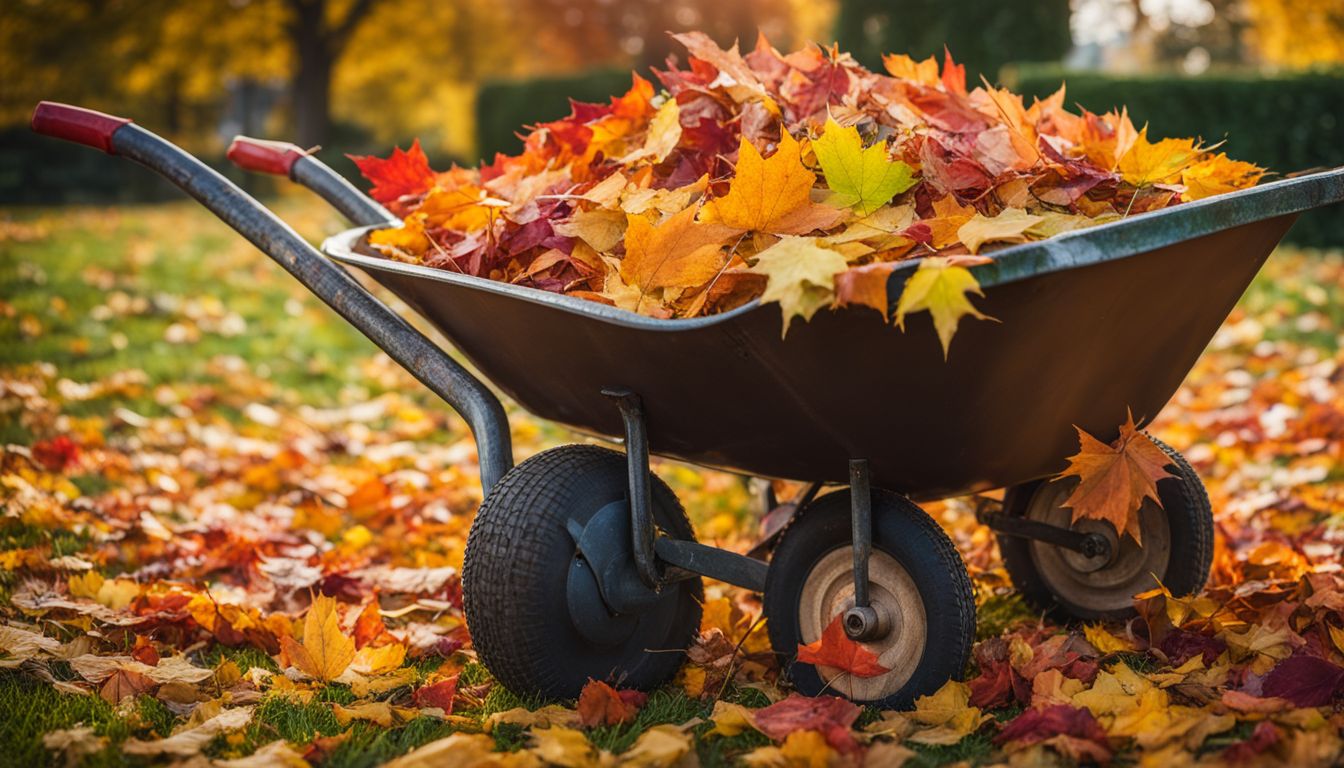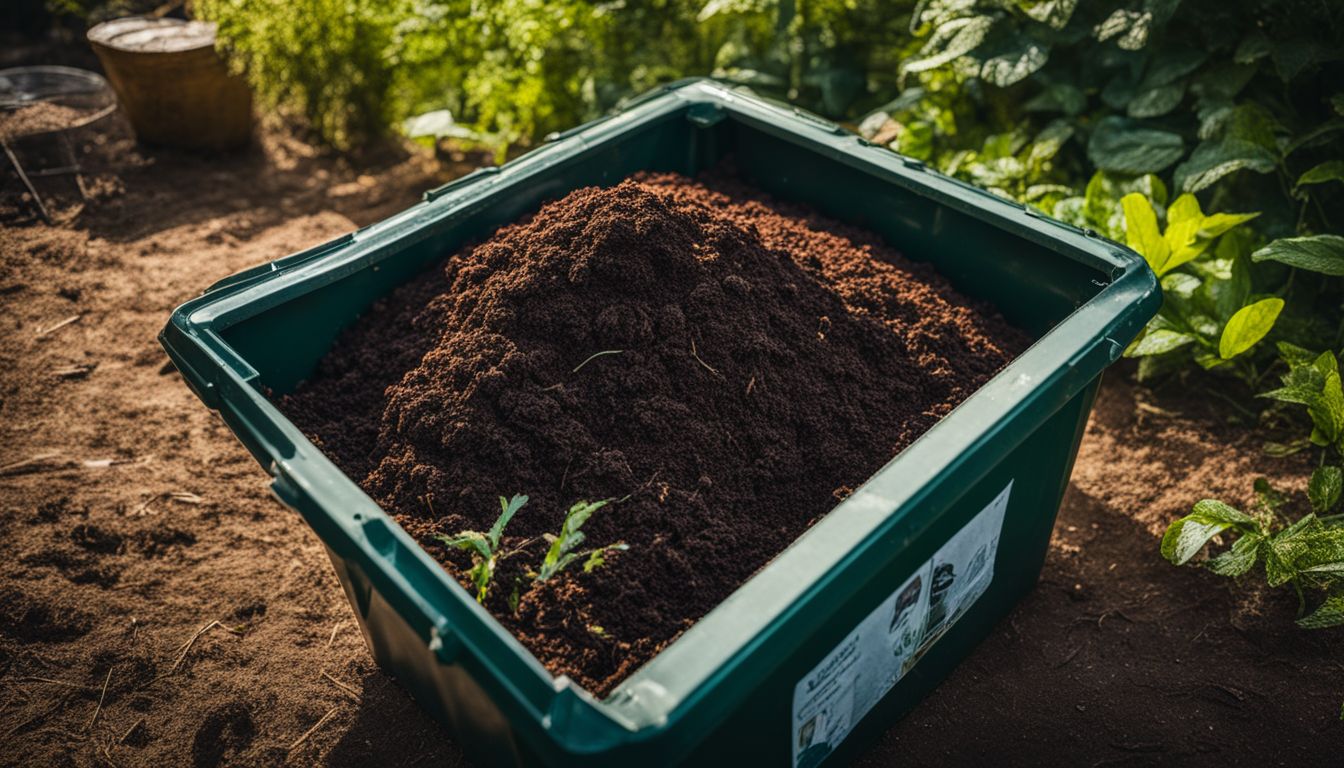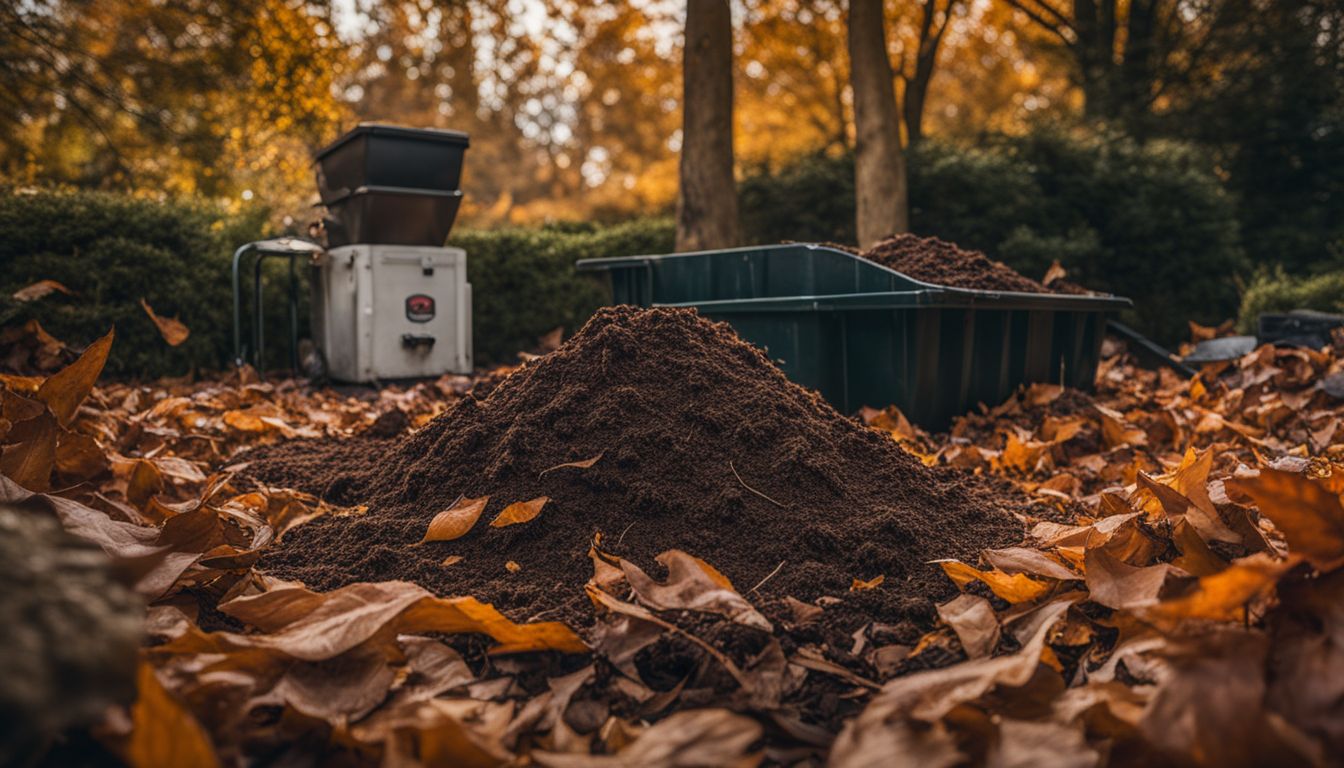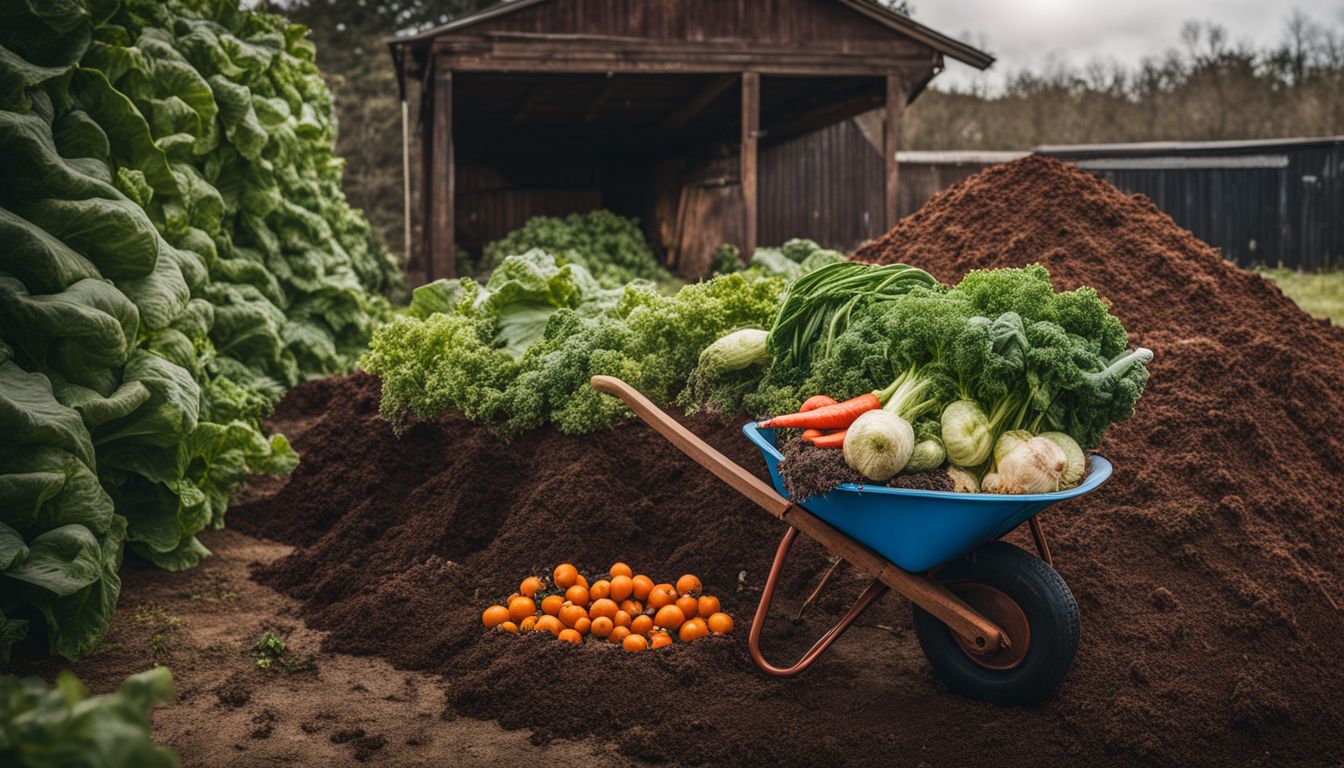Many garden enthusiasts wonder, “Can I start composting in the fall?”. The answer is a resounding yes! This post will guide you through the benefits of autumn composting and teach you how to create your own nutrient-rich compost pile.
Keep reading to turn those fallen leaves and yard waste into gardening gold.
Key Takeaways
- Yes, you can start composting in the fall. It’s a great time to gather leaves and grass clippings for your compost pile.
- Utilizing dry leaves and dead annual plants in the fall adds carbon to your compost, creating nutrient-rich organic matter for your garden or lawn next year.
- Balancing carbon-rich materials like dry leaves with nitrogen-rich materials like grass clippings helps create high-quality compost.
- To ensure successful fall composting, chop and shred your materials, layer them properly, store extra materials for future use, and consider using an enclosed composter or covering the pile.
Benefits of Fall Composting
 Fall composting offers several benefits such as gathering leaves and grass clippings, utilizing dry leaves and dead annual plants, increasing carbon-rich matter, and balancing compost with nitrogen.
Fall composting offers several benefits such as gathering leaves and grass clippings, utilizing dry leaves and dead annual plants, increasing carbon-rich matter, and balancing compost with nitrogen.
Gathering leaves and grass clippings

Fall is a great time to collect leaves and grass clippings for composting. The leaves turn dry and fall off their trees, making them easy to gather. Grass clippings can be picked up after mowing the lawn.
Both add carbon-rich matter to your compost pile, which helps with decomposition. Be sure not to include any diseased or pest-ridden material in your compost bin, as this could harm your garden later on!
Utilizing dry leaves and dead annual plants

In the fall, you can gather dry leaves and dead annual plants to use in your compost pile. These materials are great for adding carbon to your compost, which is important for balancing it out.
Dry leaves provide a good source of carbon, while dead annual plants add diversity to the mix. By utilizing these materials, you’ll be able to create a nutrient-rich compost that will benefit your garden or lawn next year.
So don’t let those fallen leaves go to waste – turn them into valuable organic matter for your compost!
Increasing carbon-rich matter

To create a successful compost pile in the fall, it’s important to increase the amount of carbon-rich matter. This means gathering dry leaves and dead annual plants, which provide an excellent source of carbon for your compost.
These materials are abundant during the autumn season and will help balance out the nitrogen-rich components in your compost pile. By increasing carbon-rich matter, you can ensure that your compost is well-balanced and nutrient-rich, providing a healthy foundation for your garden next year.
Balancing compost with nitrogen

To create high-quality compost, it’s important to balance the carbon and nitrogen in your compost pile. Carbon-rich materials like dry leaves and dead plants provide the “brown” component, while nitrogen-rich materials like grass clippings and kitchen scraps provide the “green” component.
The ideal ratio is around 30 parts carbon to 1 part nitrogen. This balance ensures that organic matter decomposes properly, leading to a rich and nutrient-dense compost that will benefit your garden or lawn.
Tips for Successful Fall Composting
Here are some tips to ensure your fall composting is a success. Read on to learn more!
Chopping and shredding compost materials

Chopping and shredding compost materials can help speed up the decomposition process and create a more uniform mixture. Here are some tips for chopping and shredding compost materials:
- Use pruners or shears to cut larger plant material into smaller pieces.
- Run a lawn mower over leaves and grass clippings to shred them into smaller fragments.
- Use a shredder or chipper to break down woody branches and stems.
- Chop up kitchen scraps like fruit peels and vegetable scraps before adding them to the compost pile.
- Smaller pieces of organic matter decompose faster because they have more surface area for microorganisms to work on.
Layering materials for optimal decomposition

To achieve optimal decomposition while fall composting, follow these steps:
- Start by layering your compost pile with a mixture of green and brown materials.
- Alternate layers of kitchen scraps, like fruit and vegetable peels, with dry leaves or shredded paper.
- Make sure each layer is evenly distributed throughout the pile to promote even decomposition.
- Avoid adding large clumps of material as they can slow down the breakdown process.
- Keep the materials moist but not wet; aim for a damp sponge – like consistency.
- If you have access to them, add some grass clippings or fresh plant trimmings to provide nitrogen.
- Continue layering until the pile reaches the desired size, making sure to finish with a layer of brown materials on top.
Storing extra materials for future composting

To ensure a continuous supply of compost, it’s helpful to store extra materials for future composting. Here are some tips for storing materials:
- Keep a designated storage area for compost materials, such as a bin or container.
- Store dry leaves, grass clippings, and other organic matter in bags or bins to protect them from moisture.
- Keep kitchen scraps in a sealed container or freezer until you’re ready to add them to the compost pile.
- If you have excess yard waste, consider shredding or mulching it before storing to save space.
- Avoid storing materials that may attract pests or rodents, such as meat, dairy products, or oily food scraps.
Using an enclosed composter or covering the pile
To protect your compost pile from the elements and help it break down faster, you can use an enclosed composter or cover the pile with a tarp. By enclosing the compost, you create a controlled environment that retains heat and moisture, speeding up decomposition.
A covered pile also prevents excess moisture from rain and snow, which can slow down the process. Additionally, it keeps pests like rodents away and reduces odors. So whether you choose an enclosed composter or cover your pile with a tarp, these methods will help create optimal conditions for successful fall composting.
Fall Composting for Beginners

For beginners looking to start composting in the fall, it is helpful to apply compost activators or accelerators to speed up the breakdown process.
Applying compost activators or accelerators

To speed up the composting process in the fall, you can use compost activators or accelerators. These products contain beneficial microorganisms that help break down organic material faster.
By adding compost activators to your compost pile, you can increase the rate of decomposition and produce nutrient-rich compost more quickly. This is especially helpful when starting a new compost pile in the fall, as it allows you to have usable compost for your garden sooner.
Compost activators are easy to use – simply follow the instructions on the product and add it to your compost pile according to the recommended dosage.
Utilizing deciduous leaves and avoiding evergreen leaves
To have a successful fall compost pile, it’s important to use the right kind of leaves. Deciduous leaves are perfect for composting in autumn because they break down easily and provide lots of carbon.
However, it’s best to avoid using evergreen leaves like holly or conifers because they break down slowly and can make your compost acidic. Stick with those colorful autumn leaves instead!
When to Add Compost to the Garden
 Adding compost in the fall is beneficial for preparing dryer and easier soil conditions in the garden before the winter months.
Adding compost in the fall is beneficial for preparing dryer and easier soil conditions in the garden before the winter months.
Adding compost in the fall for dryer and easier soil conditions

In the fall, adding compost to your soil can help make it dryer and easier to work with. Compost acts like a sponge, absorbing excess moisture and improving drainage. It also improves the structure of the soil, making it looser and more crumbly.
This makes it easier for plant roots to penetrate the soil and access nutrients. Additionally, compost adds organic matter to the soil, which provides essential nutrients for plants to grow strong and healthy.
By adding compost in the fall, you’ll be giving your garden a head start for next spring’s planting season.
Considering the timing based on the growing season

Fall is an ideal time to add compost to your garden because it allows for dryer and easier soil conditions. By adding compost in the fall, you can prepare your garden for the next growing season and provide it with valuable nutrients.
The autumn season provides a good opportunity to balance carbon-rich matter and nitrogen in your compost pile, which will help create a healthy soil environment. Furthermore, fall composting activities can recycle organic waste and produce a sustainable product that will benefit your garden all year long.
So, take advantage of the timing based on the growing season and start composting in the fall!
Conclusion

In conclusion, fall is a great time to start composting. Gathering dry leaves and dead plants provides an excellent carbon source, and the process of composting can continue throughout the winter.
By following some helpful tips and techniques, you can create nutrient-rich compost for your garden while also reducing waste. So go ahead and start composting this fall!
FAQs
1. Can I start composting in the fall?
Yes, you can! Fall is a great time to start composting. You can gather dry deciduous leaves and dead annual plants for your compost pile.
2. What can I use as a carbon source for my fall compost pile?
Dry leaves from deciduous trees or evergreen trees and dead annual plants are excellent sources of carbon for your compost pile in the fall season.
3. Do I need a Composting Accelerator to help with the breakdown process?
A Composting accelerator is not needed, but it speeds up the breakdown process during autumn by balancing carbon and nitrogen in the compost.
4. How do I add lawn fertilizer to my new autumn compost pile?
Before adding lawn fertilizer, ensure that your compost has balanced levels of carbon and nitrogen. Add small amounts of lawn fertilizer evenly across your autumn compost pile.
5. When should I add my finished fall garden compost to my vegetable or perennial garden?
Once winter ends, you can till your fresh autumn-made soil into your vegetable garden or perennial beds before planting new crops!

As a dedicated mother and passionate software developer, she weaves her diverse experiences into captivating stories that inspire and engage readers. Emma's love for sustainable living and environmental consciousness permeates both her personal and professional life. When she's not immersed in the world of coding and software development, Emma can be found nurturing her family and tending to her thriving organic garden. Her commitment to sustainable practices extends to every aspect of her life, from repurposing household items to embracing eco-friendly technologies.










